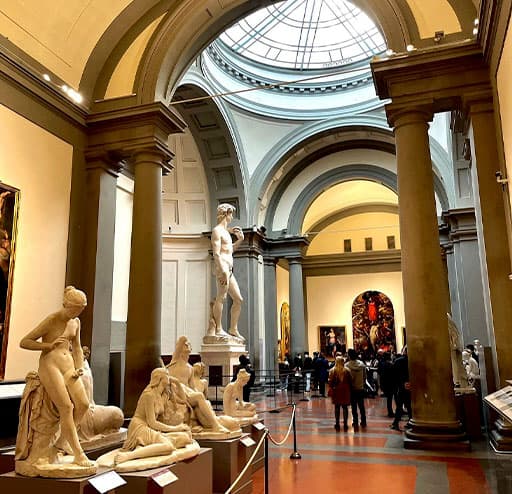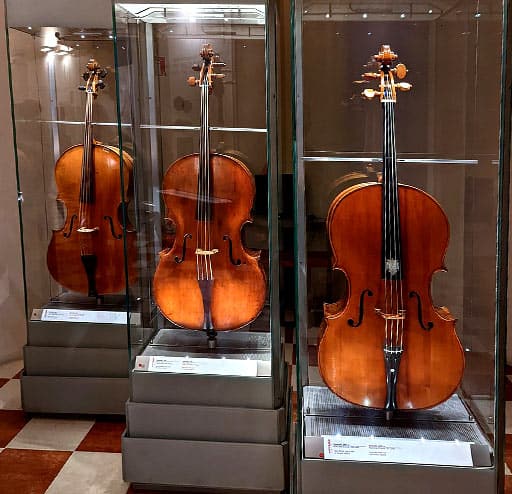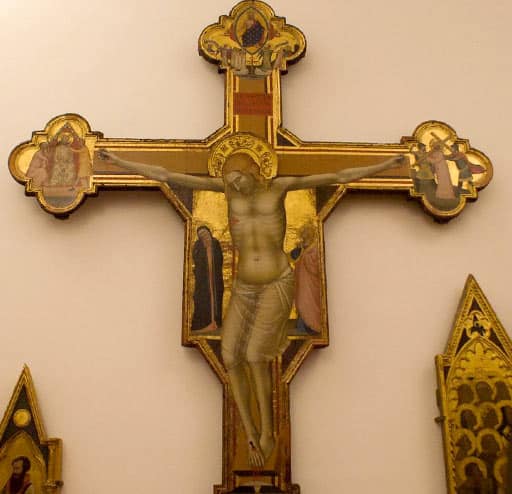Learn about the Academia Gallery by exploring its halls
At the Accademia Gallery Florence, there are seven major museum halls. Learn more about each of them below.
Hall of the Colossus

Hall of the Colossus, named after the ancient plaster casts housed here, was renovated in 2013 to take on its current form. As soon as you enter, on the same wall as the entrance, you can admire the works of Domenico Ghirlandaio, Filippino Lippi, Paolo Uccello, Perugino, and Botticelli. There are six exhibits of 15th-century altarpieces on the wall to the left, which explain how the Florentine School of art developed. This plaster cast of Giambologna is located to the right. There are three very intricate altarpieces around it: Perugino, Raffaellino del Garbo, and Filippino Lippi.
Hall of the Prisoners

In the Hall of the Prisoners, there are four sculptures of nude male figures. There is a long and intriguing history behind these sculptures. They were commissioned in 1505, which makes them older than the Sistine Chapel. Originally, the sculptures were intended as part of Pope Julius II Della Rovere’s spectacular tomb. However, because of financial constraints, Michelangelo stopped working on it halfway through its construction. Additionally, the Hall of Prisoners has artwork by Granacci, Andrea del Sarto, Fra’ Bartolomeo, Pontormo, and Michele di Ridolfo del Ghirlandaio.
The Tribune

David has always been one of Michelangelo’s most remarkable works of art. Since its completion in 1504, the sculpture has stood in Piazza Della Signoria, braving the elements. In the 1850s, David was moved to a tribune within the Accademia Gallery. This is how The Tribune came to be. The Tribune originally contained copies of many of Michelangelo’s paintings. The sculpture of David is flanked by works by artists like Bronzino, Cecchino Salviati, and Allori, whose ideas and styles seem to have been inspired by Michelangelo.
Gipsoteca Bartolini

Since 1784, when Peter Leopold, the Grand Duke of Tuscany, converted the Friary Hospital of San Matthew into a gallery for the Fine Arts Academy, this Gipsoteca Bartolini hall was part of the Accademia Gallery. One of the top professors at the Academy, Lorenzo Bartolini, contributed a number of his works to this hall. Pampaloni was another artist whose work can be found in Gipsoteca Bartolini. This hall has an exhibition of Florentine art’s evolution from New Classicism to Romanticism.
Florentine Gothic

The Florentine Gothic hall, consisting of three rooms, is the last room on the ground floor. The three rooms are devoted to the Giottesque painters, Orcagna and his brothers, and the 13th and early 14th centuries, respectively. In the first of these rooms, you will find some of the earliest works of art in the Accademia Gallery. In the second room, you will find artworks by followers of Giotto, whose works brought back nature. In the last room, the works of four artists are exhibited: Andrea, Nardo, Matteo, and Jacopo di Cione. In the hall, some paintings have recently been restored.
MUSEUM OF MUSICAL INSTRUMENTS

Perhaps the most targeted part of the Accademia Gallery is here. Over fifty musical instruments in the Museum of Musical Instruments were once an integral part of the Medicean court. In this collection, you will find stringed instruments and wind instruments, pianos and harpsichords, and early piano forms such as the ‘pianoforte,’ and the famous Viola by Stradivari. In creating these instruments, a lot of work is put into them. You can also enjoy the Museum of Musical Instruments tour through multimedia systems in addition to the instruments.
FLORENCE BETWEEN 1370 AND 1430

This hall is located on the first floor of the Accademia Gallery. Recently, it was modified to make it more appealing to visitors. A collection of art from the late 14th Century was displayed throughout this hall. In the first part of the hall, you will find artworks depicting the time’s local religious and spiritual practices. There is art in the main hall that was commissioned by the Florentine Guilds, which were responsible for the emergence and growth of the erstwhile society.
Book Accademia Gallery Ticket
Links you might find useful
Tickets & Tours
Accademia Gallery
Visitor Information
Opening Hours
Tickets and Tours
Accademia Online
Radio Accademia
Florence Attractions
Uffizi Gallery
Duomo Florence
Palazzo Pitti
More Florence Attractions
